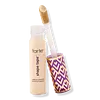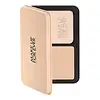What's inside
What's inside
 Key Ingredients
Key Ingredients

 Benefits
Benefits

 Concerns
Concerns

 Ingredients Side-by-side
Ingredients Side-by-side

Water
Skin ConditioningCyclopentasiloxane
EmollientCyclohexasiloxane
EmollientMethyl Methacrylate Crosspolymer
Butylene Glycol
HumectantPEG-10 Dimethicone
Skin ConditioningTrimethylsiloxysilicate
EmollientSodium Chloride
MaskingDisteardimonium Hectorite
StabilisingCetyl PEG/PPG-10/1 Dimethicone
EmulsifyingAluminum Hydroxide
EmollientAmyl Cinnamal
PerfumingBenzyl Salicylate
PerfumingConvallaria Majalis Bulb/Root Extract
Skin ConditioningDimethicone/Vinyl Dimethicone Crosspolymer
Skin ConditioningDisodium EDTA
Ethylhexylglycerin
Skin ConditioningGeraniol
PerfumingGlycyrrhiza Glabra Root Extract
BleachingHelianthus Annuus Seed Oil
EmollientHexyl Cinnamal
PerfumingHydroxycitronellal
PerfumingLeontopodium Alpinum Flower/Leaf Extract
Skin ConditioningLilium Candidum Flower Extract
Skin ConditioningLimonene
PerfumingLinalool
PerfumingMagnolia Liliflora Flower Extract
Skin ConditioningMangifera Indica Seed Butter
Skin ConditioningOlea Europaea Fruit Oil
MaskingPaeonia Lactiflora Root Extract
Skin ConditioningParfum
MaskingPhenoxyethanol
PreservativeTocopherol
AntioxidantTriethoxycaprylylsilane
Triethyl Citrate
MaskingButyrospermum Parkii Butter
Skin ConditioningUlmus Davidiana Root Extract
Skin ConditioningGlycerin
HumectantPentaerythrityl Tetra-Di-T-Butyl Hydroxyhydrocinnamate
AntioxidantTbhq
AntioxidantCI 77891
Cosmetic ColorantIron Oxides
Water, Cyclopentasiloxane, Cyclohexasiloxane, Methyl Methacrylate Crosspolymer, Butylene Glycol, PEG-10 Dimethicone, Trimethylsiloxysilicate, Sodium Chloride, Disteardimonium Hectorite, Cetyl PEG/PPG-10/1 Dimethicone, Aluminum Hydroxide, Amyl Cinnamal, Benzyl Salicylate, Convallaria Majalis Bulb/Root Extract, Dimethicone/Vinyl Dimethicone Crosspolymer, Disodium EDTA, Ethylhexylglycerin, Geraniol, Glycyrrhiza Glabra Root Extract, Helianthus Annuus Seed Oil, Hexyl Cinnamal, Hydroxycitronellal, Leontopodium Alpinum Flower/Leaf Extract, Lilium Candidum Flower Extract, Limonene, Linalool, Magnolia Liliflora Flower Extract, Mangifera Indica Seed Butter, Olea Europaea Fruit Oil, Paeonia Lactiflora Root Extract, Parfum, Phenoxyethanol, Tocopherol, Triethoxycaprylylsilane, Triethyl Citrate, Butyrospermum Parkii Butter, Ulmus Davidiana Root Extract, Glycerin, Pentaerythrityl Tetra-Di-T-Butyl Hydroxyhydrocinnamate, Tbhq, CI 77891, Iron Oxides
Synthetic Fluorphlogopite
Boron Nitride
AbsorbentPentaerythrityl Tetraisostearate
EmollientSilica
AbrasivePolymethyl Methacrylate
Alumina
AbrasiveZinc Laurate
Methicone
EmollientDimethicone
EmollientCaprylyl Glycol
EmollientEthylhexylglycerin
Skin ConditioningSodium Dehydroacetate
PreservativeAluminum Hydroxide
EmollientHydrogen Dimethicone
Tocopherol
AntioxidantCI 77491
Cosmetic ColorantCI 77492
Cosmetic ColorantCI 77499
Cosmetic ColorantCI 77891
Cosmetic ColorantCI 77163
Cosmetic ColorantSynthetic Fluorphlogopite, Boron Nitride, Pentaerythrityl Tetraisostearate, Silica, Polymethyl Methacrylate, Alumina, Zinc Laurate, Methicone, Dimethicone, Caprylyl Glycol, Ethylhexylglycerin, Sodium Dehydroacetate, Aluminum Hydroxide, Hydrogen Dimethicone, Tocopherol, CI 77491, CI 77492, CI 77499, CI 77891, CI 77163
 Reviews
Reviews

Ingredients Explained
These ingredients are found in both products.
Ingredients higher up in an ingredient list are typically present in a larger amount.
Aluminum Hydroxide is a form of aluminum. It can be naturally found in nature as the mineral gibbsite. In cosmetics, Aluminum Hydroxide is used as a colorant, pH adjuster, and absorbent.
As a colorant, Aluminum Hydroxide may add opacity, or reduce the transparency. Aluminum hydroxide is contains both basic and acidic properties.
According to manufacturers, this ingredient is an emollient and humectant. This means it helps hydrate the skin.
In medicine, this ingredient is used to help relieve heartburn and help heal ulcers.
There is currently no credible scientific evidence linking aluminum hydroxide in cosmetics to increased cancer risk.
Major health organizations allow the use of aluminum hydroxide in personal care products and have not flagged it as a carcinogenic risk at typical usage levels.
Learn more about Aluminum HydroxideCi 77891 is a white pigment from Titanium dioxide. It is naturally found in minerals such as rutile and ilmenite.
It's main function is to add a white color to cosmetics. It can also be mixed with other colors to create different shades.
Ci 77891 is commonly found in sunscreens due to its ability to block UV rays.
Learn more about CI 77891Ethylhexylglycerin (we can't pronounce this either) is commonly used as a preservative and skin softener. It is derived from glyceryl.
You might see Ethylhexylglycerin often paired with other preservatives such as phenoxyethanol. Ethylhexylglycerin has been found to increase the effectiveness of these other preservatives.
Tocopherol (also known as Vitamin E) is a common antioxidant used to help protect the skin from free-radicals and strengthen the skin barrier. It's also fat soluble - this means our skin is great at absorbing it.
Vitamin E also helps keep your natural skin lipids healthy. Your lipid skin barrier naturally consists of lipids, ceramides, and fatty acids. Vitamin E offers extra protection for your skin’s lipid barrier, keeping your skin healthy and nourished.
Another benefit is a bit of UV protection. Vitamin E helps reduce the damage caused by UVB rays. (It should not replace your sunscreen). Combining it with Vitamin C can decrease sunburned cells and hyperpigmentation after UV exposure.
You might have noticed Vitamin E + C often paired together. This is because it is great at stabilizing Vitamin C. Using the two together helps increase the effectiveness of both ingredients.
There are often claims that Vitamin E can reduce/prevent scarring, but these claims haven't been confirmed by scientific research.
Learn more about Tocopherol